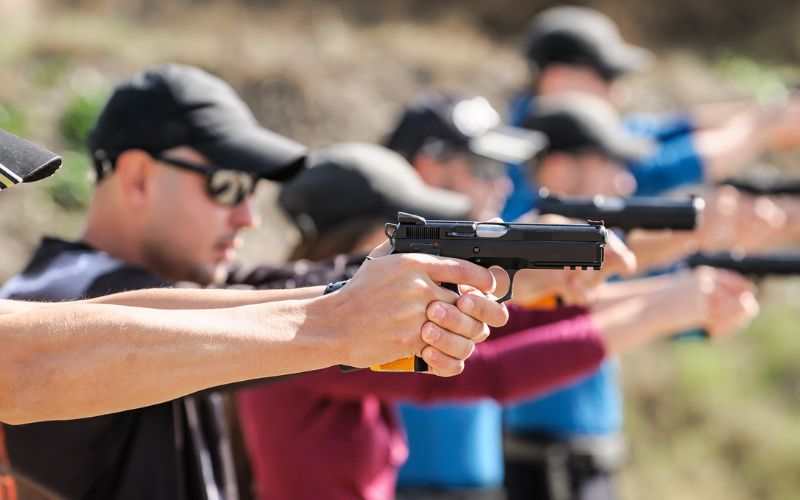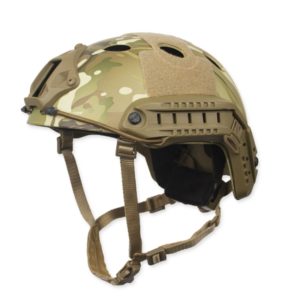Combat Helmets vs. Ballistic Helmets: What’s the Difference?

Helmets are essential protective gear used by military, police officers, and civilians in dangerous situations. Though helmets are one type of protective gear, several types are designed for different purposes. The two most common helmet types used in combat scenarios are combat helmets and ballistic helmets. Though the terms are often used interchangeably, there are quite a few differences between them, especially regarding protection level and the material used in making them.
This blog will focus on the major differences between combat helmets and ballistic helmets, discussing how they work, their pros, and what to look for when selecting a helmet for your purposes.
What Is A Combat Helmet?
A combat helmet protects a wearer from blunt trauma, shrapnel, and low-velocity projectiles. These are important to the military, law enforcement, or anyone who could be subjected to their service to dangerous scenarios of explosions, falls, or another type of blunt force impact.
Features Of Combat Helmets
Combat helmets come with a bunch of cool features. Here are a few of them discussed below:
Blunt Force Protection
Combat helmets are designed to absorb and distribute the energy of blunt objects to prevent skull fractures and severe concussions. Such protection is crucial in combat, where troops are likely to be exposed to falling debris, strikes from improvised weapons, or vehicle impact.
Materials
Combat helmets are made from fiberglass, Kevlar, or polycarbonate plastic. These materials are strong yet light in weight, allowing the wearer to move about with agility while offering decent protection.
Design

Combat helmets are usually more open than ballistic helmets. There is less focus on full-face protection. The primary objective is to provide adequate head protection while ensuring the wearer can move comfortably, use communications gear, and perform operations without excessive strain.
Uses: Combat helmets apart from the army can be utilized extensively for policing services and specific racing motorcycles whose demand requires blunt trauma protection and insignificance for high-level ballistic threats.
What Are Ballistic Helmets?
Since ballistic helmets protect against bullet and shrapnel attacks, they provide protection superior to standard combat helmets. They can be worn during military, police, and even other high-risk engagements where bullets and high-speed rounds are the present threats.
Key Features Of Ballistic Helmets
Important characteristics of ballistic Helmets are as follows:
Ballistic Protection
A ballistic helmet protects the wearer from penetration by high-velocity bullets and fragments of explosives. It is built using multiple layers of materials that are highly resistant to penetration and can absorb most energy from incoming projectiles.
Materials
The ballistic helmets use advanced materials that include Aramid fibers, Kevlar, Ultra-High-Molecular-Weight Polyethylene, and composite materials made of carbon fibers. These are highly resistant to penetration and light in weight, so one can wear them without undue strain.
Design
Ballistic helmets are usually bulkier than standard combat helmets because they need layers of protective material to provide ballistic defense effectively. Some have additional face or neck protection, visors integrated into the helmet, or ear protection for comprehensive defense against ballistic threats and environmental factors.
Uses: Ballistic helmets are mainly used in combat operations, especially when troops are at risk of being fired upon. They are also used by tactical police units and security personnel operating in high-risk environments, such as hostage rescue missions or active shooter situations.
Key Differences Between Combat Helmets and Ballistic Helmets
While both helmets are designed to protect the wearer, there is a clear difference between combat and ballistic helmets in the level of protection provided and the material used.
1. Level of Protection
The key difference between a combat helmet and a ballistic helmet is the protection they offer:
Combat Helmets: Primarily designed to protect against blunt force trauma, such as blows from melee weapons, shrapnel, or debris. Combat helmets offer some protection from low-velocity projectiles but are not designed to stop bullets.
Ballistic Helmets: They are designed to stop high-velocity projectiles such as bullets and shrapnel from explosives. The ballistic protection level varies with the design and material, but they are specifically designed to protect against gunfire, making them superior in defensive capability.
2. Material and Construction
Both types of helmets use strong materials, but the focus on the material properties differs:
Combat Helmets: Made of fiberglass, polycarbonate, or Aramid fibers, these materials can absorb the energy of blunt impacts but not ballistic threats.
Ballistic Helmets: Made of advanced materials like Kevlar, UHMWPE, and composite fibers, ballistic helmets are designed to withstand high-velocity bullets, and they are much stronger in resisting penetration from sharp objects and shrapnel.
3. Weight and Comfort
Combat Helmets: They are generally lighter than ballistic helmets because of their simpler design. The idea is to protect the wearer with the least weight so that he or she can perform many tasks without weight hindrance.
Ballistic Helmets: Generally weigh more than combat helmets, particularly at higher protection levels. The additional weight is because of the extra materials needed to provide ballistic resistance, making long-term wear more strenuous on the body.
4. Design and Coverage
Combat Helmets: Provide overall protection but generally only on the head’s top, back, and sides. They are built to be easily mobile, with less focus on the face or neck.
Ballistic Helmets: In most cases, the helmets provide wider coverage ranges, with some models even including face shields or neck guards to increase protection. Its design may be bulkier, but it aims to be holistic for its users and offers complete protection in dangerous situations.
Choosing The Best Helmet for You

Determine which combat or ballistic helmet you need by identifying the threats thrown at you.
For Military and Law Enforcement: If you are in a position where you might encounter bullets or high-velocity projectiles, a ballistic helmet is necessary. However, for environments where blunt force protection (from shrapnel, debris, or low-velocity threats) is the primary concern, a combat helmet may be sufficient.
For Civilian Use: You might consider getting a combat helmet if you participate in activities in which blunt trauma is the highest threat (for example, motorcycle or other sports activities). However, the best choice is to buy a ballistic helmet, especially for individuals in a dangerous zone or for tactical training and security activities.
Verdict
The key conclusion is that combat helmets and ballistic helmets are quite different in their application, as combat helmets are meant to protect against blunt impact, low-velocity impacts. In contrast, ballistic helmets protect against high-velocity impacts, such as bullets. Therefore, it will depend on what kind of threat one faces and the environment in which the person will perform their duties.
Frequently Asked Questions
Can a combat helmet stop bullets?
No, combat helmets are not made to stop bullets. They are designed primarily to protect against blunt force trauma and shrapnel but provide minimal protection against high-velocity projectiles.
Are ballistic helmets heavy?
Ballistic helmets are typically heavier than combat helmets because of the added materials needed to provide ballistic protection. Modern designs, however, seek to balance security with comfort and mobility.
Do ballistic helmets provide full head protection?
While ballistic helmets offer better protection for the head’s top, sides, and back, they do not always cover the face or neck. However, some models have additional protection, such as face shields or neck guards, for complete defense.

